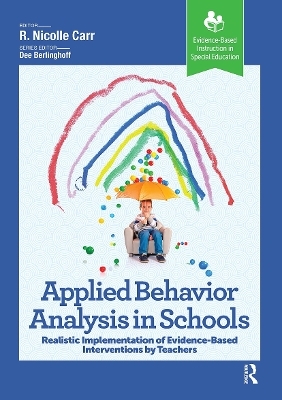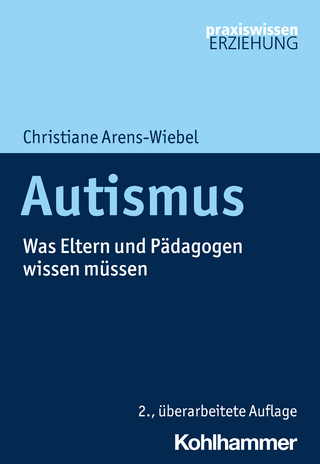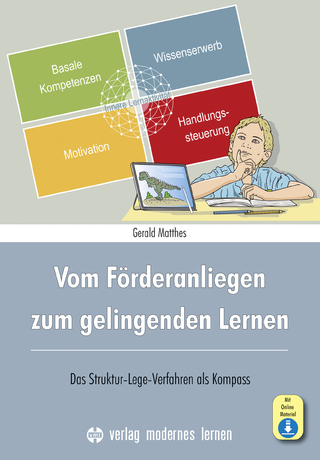
Applied Behavior Analysis in Schools
SLACK Incorporated (Verlag)
978-1-63822-120-3 (ISBN)
Dr. R. Nicolle Carr leverages her years of expertise with ABA and channels it into creating practical, realistic working models of ABA that any teacher can use. Her “by teachers, for teachers” approach to writing effectively outlines ABA strategies so that they can be used with few resources and minimal training.
Applied Behavior Analysis in Schools is tailored toward future and current educators to enable them to learn invaluable tools like how to effectively take data in a classroom to help with academic performance or behavior management—without requiring them to possess a background in ABA.
What’s included in Applied Behavior Analysis in Schools:
Chapters on Acceptance and Commitment Therapy
The role of cultural considerations and collaboration skills
Use of ABA in transition skills
Applying ABA to academics and an overview of assessments
Included with the text are online supplemental materials for faculty use in the classroom.
Applied Behavior Analysis in Schools: Realistic Implementation of Evidence-Based Interventions by Teachers takes the concepts of ABA and presents them to teachers in a way that is both approachable and applicable.
Dr. R. Nicolle Carr started her education at Oklahoma City University's psychology program before heading down to Austin to attend the University of Texas’s psychology/behavior neuroscience department. She worked in two labs concurrently - one studying the effect of conditioning on the mating behavior of quail and another lab learning genetic sequencing, slicing brain tissue, and metabolic imaging. Finally, she left with a PhD and joined the 9 to 5 rat race at a residential treatment facility for individuals with significant behavior problems. In 2008, she became a Board Certified Behavior Analyst and has been teaching both online and in person for more than 20 years. Back in Oklahoma for the past 10 years, she has consulted in various school districts on functional behavior assessment development and provided district-wide classroom management trainings. It was during this time that she noted how many times what is learned in general applied behavior analysis (ABA) textbooks or journal articles doesn’t always translate into classrooms. For 4 years, she also served as the Director of the ABA program at the University of Oklahoma and helped many students on their own certification journey. Most recently, she became the Clinical Director of an ABA clinic in a rural area of Oklahoma. Dr. Carr has written chapters on ethics in research methods and ethics in rural treatment in ABA. She has served as the secretary of the ABAi’s Ethics SIG and founded the Oklahoma chapter of ABAi (OKABA). Across the last decade, she has served on conference panels, given invited lectures, and 8-hour workshops related to using ABA in schools. When not working, Dr. Carr enjoys pushing her physical limits. In June 2014, 2016, and 2018, she and her husband hiked 210 miles of a pilgrimage called the Camino de Santiago across Spain. In July 2022, they summited Kilimanjaro—the most amazing and brutal hiking experience ever!
Contents Contents Acknowledgments About the Editor Contributing Authors Introduction Chapter 1 Big Picture: Behavior Analysis Is More Than Just Classroom Management R. Nicolle Carr, PhD, BCBA-D, LBA-OK; Mia Dianda, MS, BCBA, LBA-OK; and Leslie S. Williams, MEd, BCBA, LBA-OK Chapter 2 Taking on the Elephant in the Room: Classroom Management Art Dowdy, PhD, BCBA-D; Kathryn Burke, PhD; and Christopher Bloh, PhD, BCBA-D Chapter 3 Culturally Responsive Collaboration: Including Everyone at the Table Joshua M. Pulos, PhD, BCBA and Jana M. Sarno, MA, BCBA Chapter 4 Data! You Have to Have Them, But How Do You Get Them? Ways to Accurately Measure Behavior in an Educational Setting Andrea L. Suk, PhD Chapter 5 Assessment of Behavior: Preference, Language, Academics, and Everything in Between Sarah Heiniger, MEd, EdS, NCSP, BCBA, LBA-OK; Brittany L. Hott, PhD, BCBA-D, LBA-OK; and Jasmine Justus, MEd, BCBA, LBA-OK Chapter 6 Why Are They Doing That? Using Functional Behavior Assessment to Understand Problem Behavior B. Scott Singleton, PsyD, BCBA-D, NCSP Chapter 7 Using Reinforcement Strategies to Promote Positive Student Outcomes in the Classroom Benjamin S. Riden, PhD, BCBA-D and Kathleen M. Randolph, EdD, BCBA-D Chapter 8 You Want Me to Do What? Effective Strategies for Teaching New Skills Sara M. Snyder, PhD, BCBA-D and Benjamin S. Riden, PhD, BCBA-D Chapter 9 When Reinforcement Does Not Work: Troubleshooting Behavior Interventions for Success Emily M. Kuntz, PhD, BCBA and Mary Crnobori, PhD, BCBA Chapter 10 Methods to Decrease Behavior: Punishment–Behavior Reduction Procedures in Schools Lesley A. Shawler, PhD, BCBA; Manish Goyal, MA, BCBA; and R. Nicolle Carr, PhD, BCBA-D, LBA-OK Chapter 11 Academic Skills Are Behaviors, Too! Using the Instructional Hierarchy to Improve Student Performance Corey Peltier, PhD; Andrew Heuer, MEd; Fanee Webster, MEd; and Amanda M. VanDerHeyden, PhD Chapter 12 Including the Excluded: Puberty, Development, and Comprehensive Sexuality Education for Students With Disabilities Tracy E. Sinclair, PhD, BCBA-D; James Sinclair, PhD; and Joshua M. Pulos, PhD, BCBA Chapter 13 Using Applied Behavior Analysis Methodology to Improve Transition to Postsecondary Education and Employment Mindy E. Lingo, PhD, BCBA-D; Malarie E. Deardorff, PhD; and Kendra Williams-Diehm, PhD, BCBA Chapter 14 Acceptance and Commitment Therapy for Teachers and Students: A Prosocial Approach to Classroom Management and Social and Emotional Learning Heather Eisel, PhD, BCBA-D, LBA; Tracy E. Sinclair, PhD, BCBA-D; and Michael G. Gentile, PhD Chapter 15 Application Scenarios R. Nicolle Carr, PhD, BCBA-D, LBA-OK Glossary Financial Disclosures Index
| Erscheinungsdatum | 22.08.2023 |
|---|---|
| Reihe/Serie | Evidence-Based Instruction in Special Education |
| Verlagsort | Thorofare |
| Sprache | englisch |
| Maße | 178 x 254 mm |
| Gewicht | 566 g |
| Themenwelt | Sozialwissenschaften ► Pädagogik ► Sonder-, Heil- und Förderpädagogik |
| ISBN-10 | 1-63822-120-0 / 1638221200 |
| ISBN-13 | 978-1-63822-120-3 / 9781638221203 |
| Zustand | Neuware |
| Haben Sie eine Frage zum Produkt? |
aus dem Bereich


